- 1Department of Surgical Oncology, Roswell Park Comprehensive Cancer Center, Buffalo, NY, United States
- 2Department of Gastroenterological Surgery, Yokohama City University Graduate School of Medicine, Yokohama, Japan
- 3Department of Biostatistics and Bioinformatics, Roswell Park Comprehensive Cancer Center, Buffalo, NY, United States
- 4Division of Digestive and General Surgery, Niigata University Graduate School of Medical and Dental Sciences, Niigata, Japan
- 5Department of Breast Surgery, Fukushima Medical University School of Medicine, Fukushima, Japan
- 6Department of Surgery, Jacobs School of Medicine and Biomedical Sciences, State University of New York, Buffalo, NY, United States
Background: Adenosine Triphosphate (ATP) is mainly generated by oxidative phosphorylation in non-malignant cells, whereas malignant cells rely predominantly on glycolysis for energy production, known as the “Warburg effect.” This study used the gene set variation analysis (GSVA) algorithm to evaluate glycolysis signaling in hepatocellular carcinoma (HCC), and investigated its relationship with tumor aggressiveness and patient prognosis.
Methods: Enhanced level of glycolysis signaling was measured using the “Hallmark-GLYCOLYSIS” gene set in the MSigDB, applied via GSVA across multiple independent HCC cohorts.
Results: There was no significant difference in glycolysis signaling between HCC and other liver diseases in two cohorts. However, enhanced glycolysis signaling linked to gene sets associated with cell proliferation and cancer-promoting pathways, such as unfolded protein response, epithelial mesenchymal transition, and apoptosis, consistently in both cohorts. HCC with high glycolysis signaling score showed increased homologous recombination deficiency (p = 0.004), intratumor heterogeneity (p = 0.005), and mutation burden (p = 0.022). No consistent associations with glycolysis were observed with immune cells infiltration nor cytolytic activity, except for Th1 cells. Clinically, high glycolysis signaling correlated with advanced tumor stage and significantly worse survival outcomes, serving as an independent prognostic biomarker [hazard ratio (HR) = 6.78 and p < 0.001 in OS, HR = 6.56 and p = 0.027 in DSS].
Conclusion: Elevated glycolysis signaling is linked to enhanced malignant pathways, genomic instability, and worse clinical outcomes in HCC, indicating its potential as a prognostic biomarker.
1 Introduction
In non-malignant cells, Adenosine Triphosphate (ATP) produced by mitochondrial oxidative phosphorylation provides most of the energy required for cellular metabolism. In contrast, malignant cancer cells are known to prioritize glycolysis over oxidative phosphorylation for their energy demands (1, 2). Cancer cell energy metabolism is characterized by active glucose uptake and aerobic glycolysis (3). While a seemingly uneconomic method of energy supply, it is required by cancer cells for biosynthesis and continued proliferation. Termed the “Warburg effect,” this feature of cancer cell energy metabolism was first observed by Otto Warburg in the 1920s (4).
Progression and patient survival of hepatocellular carcinoma (HCC) have been linked to the activation of glycolysis pathways (5). Elevated glycolysis activity in tumor cells is correlated with more aggressive cancer phenotypes and worse patient survival. To this end, glycolysis-related marker expressions are expected to serve as prognostic indicators. Currently many studies are focusing on therapies that target glycolytic enzymes and pathways. Specifically, inhibiting pivotal enzymes such as hexokinase 2 (HK2) and pyruvate kinase M2 (PM2) could potentially disrupt the energy supply of cancer cells, thereby hindering tumor growth. Moreover, glycolytic pathway activation is recognized as a contributing factor to treatment resistance. Therefore, combination therapies that target the glycolytic system hold promise for overcoming this resistance and enhancing therapeutic efficacy (6).
To date, numerous attempts have been made to identify a gene expression that reflects the aggressiveness of cancer and be used as a biomarker. For example, we have recently reported that Ki67 gene expression is associated with aggressive phenotype of HCC (7) while Spinster homolog 2 expression correlates with improved HCC patient survival (8). However, the heterogeneity and complexity of tumor biology often limit the predictive power of single-gene approaches. To address this, gene set variation analysis (GSVA) has emerged as a method to capture pathway-level activity across tumors, offering a more integrated view of cancer biology. In our previous studies, we utilized the GSVA method to demonstrate that various gene set pathway scores, such as reactive oxygen species, apical junctions, bile acid metabolism, or E2F targets, are associated with certain clinical outcomes in cancer (9–12). We have also published that BRCAness scoring can serve as a more effective biomarker compared to individual BRCA gene analysis (13). Indeed, we have previously generated a GSVA algorithm to reflect glycolysis activity and found that increased glycolysis in tumor microenvironment was associated with worse survival in triple-negative but not hormone receptor-positive breast cancers (13).
In this study, we applied a previously validated glycolysis pathway score to multiple HCC cohorts to evaluate its clinical relevance, including associations with genomic alterations, tumor immune microenvironment, and patient survival.
2 Materials and methods
2.1 Acquisition of HCC samples
655 samples with mRNA expression and clinicopathological data were obtained from multiple public databases including the Cancer Genome Atlas (TCGA) (14) and GSE6764 (15), 76427 (16), and 89377 (17) cohorts.
2.2 Glycolysis signaling score
Gene Set Variation Analysis (GSVA) is an unsupervised, non-parametric method for estimating variations in gene set enrichment across individual samples in an expression dataset. Unlike traditional gene set enrichment analysis (GSEA), which compares predefined groups of samples, GSVA evaluates each sample on an individual basis. This approach enables researchers to identify changes in pathway activity at the single-sample level, which is particularly valuable for uncovering variable biological processes or pathways in studies of complex diseases such as cancer. GSVA is especially useful in cases where sample classifications are either unavailable or unclear (18, 19). In this study, the enhanced level of glycolysis signaling in individual samples was assessed using the score values calculated by the GSVA algorithm. The gene sets related to glycolysis signaling were identified using the Molecular Signatures Database (MSiGB).
2.3 Biological function analysis
A gene set variation analysis (GSEA) algorithm (20) was used to demonstrate the differentiation of biological function of hallmark cancer signaling between low and high inflammatory response signaling HCC within each cohort. Pathways demonstrating significant enrichment were analyzed according to GSEA recommendations with a set false discovery rate (FDR) of <25%. As we have previously reported, the MSigDB gene set collection was utilized to obtain hallmark cancer gene sets (21–25).
2.4 Other scores
As previously demonstrated by our group, the cytolytic activity score (CYT) was calculated using the geometric mean of the expression values of granzyme A (GZMA) and perforin (PRF1) measured in transcripts per million (TPM) (26–28). To evaluate the composition of the intra-tumor microenvironment, cellular fractions of 64 unique immune and stromal cell types were estimated by an xCell algorithm as we have previously demonstrated (29–33).
2.5 Statistical analysis
The threshold for categorizing low and high glycolysis signaling groups was set at the top quartile of points within each cohort. Kruskal-Wallis or Mann-Whitney U tests were used for comparisons between groups. To examine the relationship between the score and patient survival outcomes, univariate and multivariate Cox regressions were utilized. Statistical analysis and data visualization were executed with R (version 4.1.0) and Microsoft Excel (version 16), with a p-value < 0.05 considered statistically significant.
3 Results
3.1 The glycolysis signaling level was similar in several forms of liver disease including HCC
We first investigated the differential levels of enhanced glycolysis signaling in liver tissue samples representative of several forms of liver disease. We found that there were no significant differences in glycolysis signaling score between HCC and other forms of liver disease including dysplastic nodule and cirrhosis, but that significant differences were present between normal tissue and HCC in the GSE6764 cohort (Figure 1). There were also no differences between HCC and other forms of liver disease including dysplastic nodule, chronic hepatitis, and cirrhosis in the GSE89377 cohort.
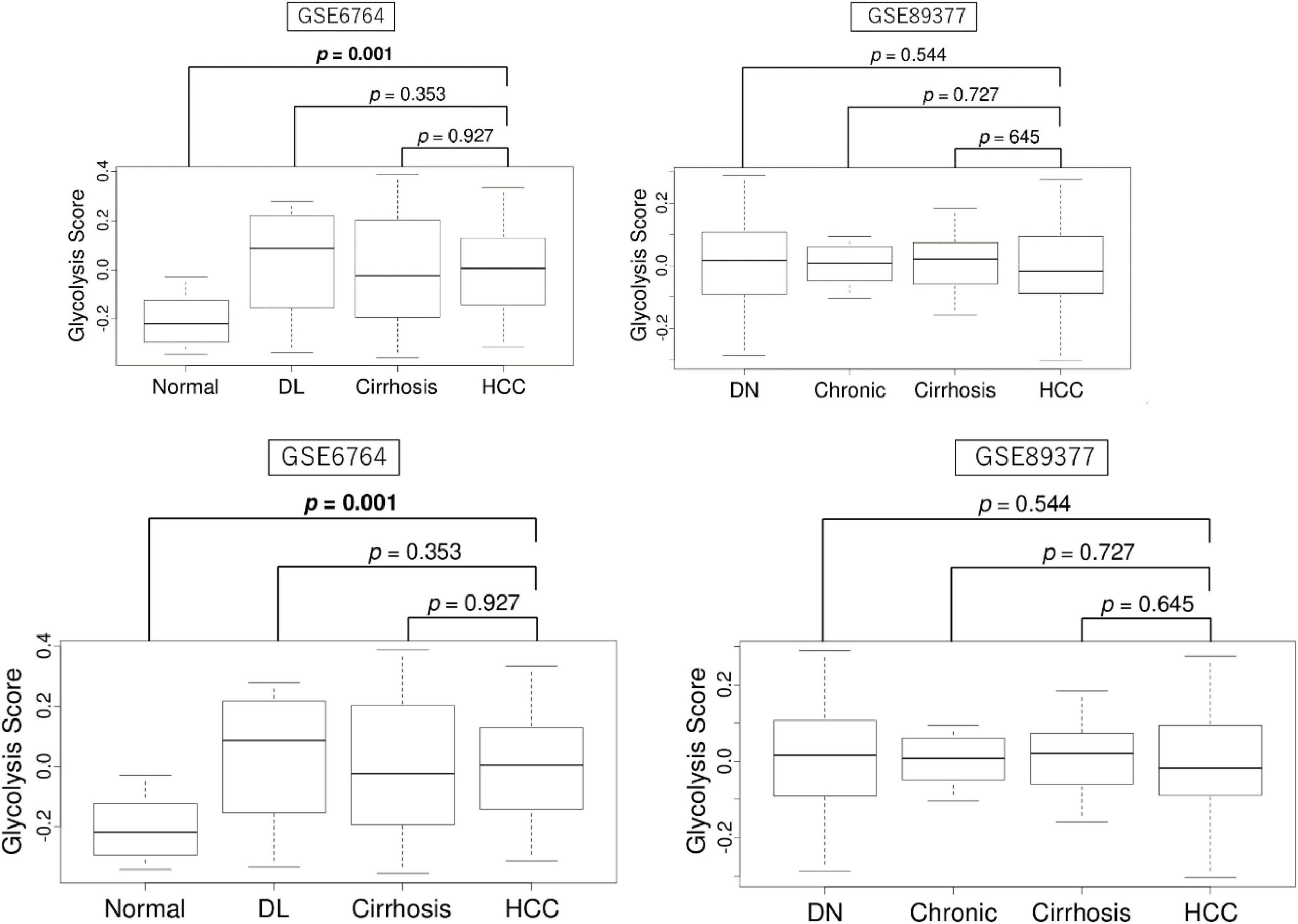
Figure 1. The enhanced level of glycolysis signaling in liver tissues during the carcinogenic sequence of HCC. (A) Boxplots of glycolysis signaling score of normal liver tissue, dysplastic nodule (DL), cirrhosis, and HCC (n = 10, 17, 13, and 35, respectively) in the GSE6764 cohort and by normal liver tissue, dysplastic nodule (DN), chronic hepatitis, cirrhosis, and HCC (n = 13, 22, 20, 12, and 40, respectively) in the GSE89377 cohort. Kruskal-Wallis and Mamm-Whitney U tests were used to investigate for significant differences between groups.
3.2 High levels of glycolysis signaling in HCC enriched cell proliferation-related and other pro-cancerous gene sets
Based on the gene set enrichment analysis algorithm with the MSigDB hallmark gene set collection, the high glycolysis signaling score group was observed to be related to cell proliferation-related gene sets, including G2M checkpoint, E2F targets, MYC targets v1, and MITOTIC spindle consistently in both TCGHA and GSE76427 cohorts (Figure 2A). Furthermore, they also highly enriched other pro-cancerous signaling, including unfolded protein response, reactive oxygen species pathway, protein secretion, PI3K/AKT/MTOR signaling, MTORC1 signaling, hypoxia, estrogen response late, epithelial mesenchymal transition, DNA repair, apoptosis, and androgen response consistently both cohorts (Figure 2B). These results demonstrated that enhanced level of glycolysis signaling was involved in the activity of various hallmark signaling pathways of cancer.
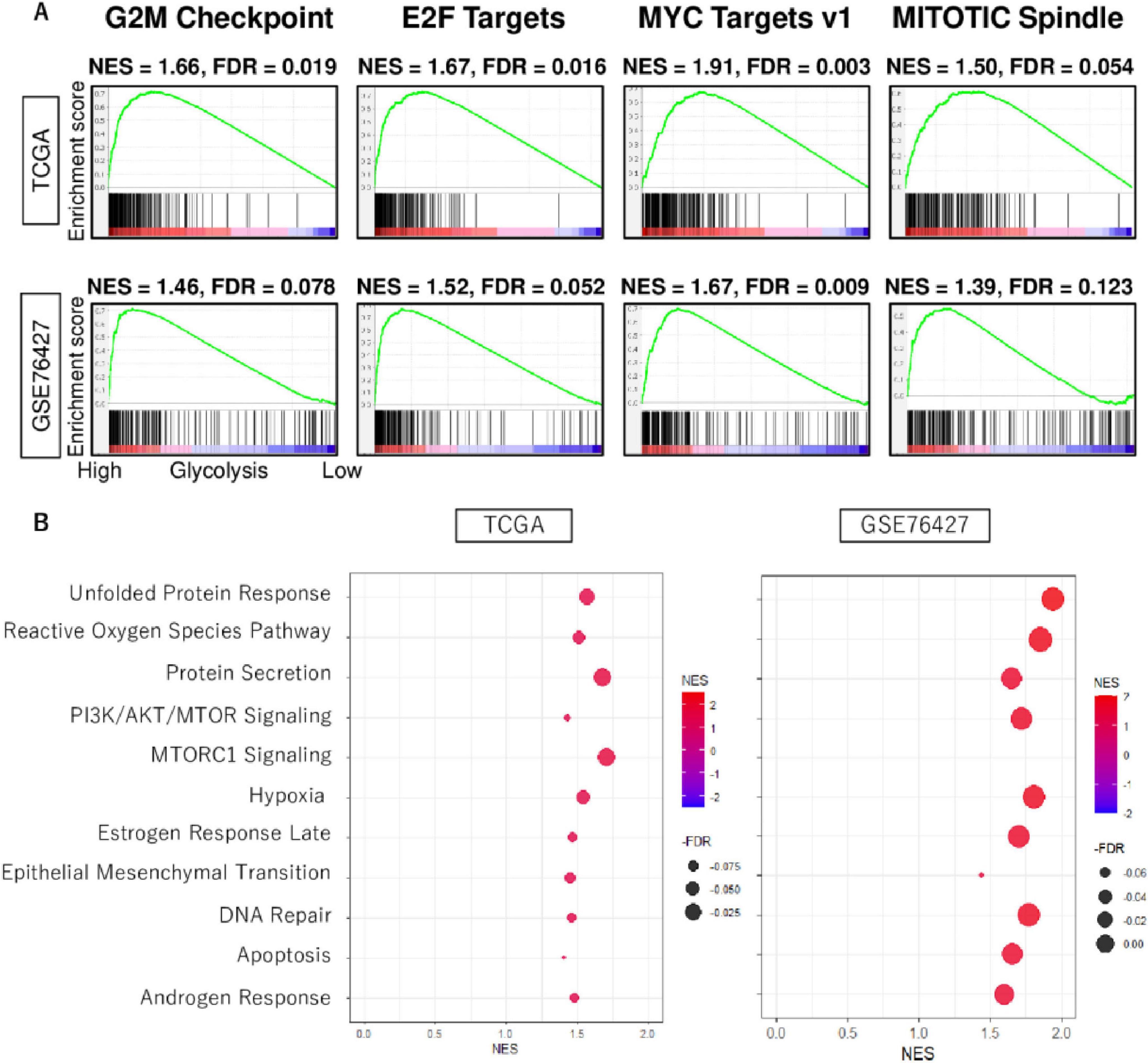
Figure 2. The biological function features of high glycolysis signaling score in HCC. (A) Enrichment curves of cell proliferation-related gene sets; G2M checkpoint, E2F targets, MYC target v1, and MITOTIC spindle in TCGA and GSE76427 cohorts. (B) Dot plots of unfolded protein response, reactive oxygen species pathway, protein secretion, PI3K/AKT/MTOR signaling, MTORC1 signaling, hypoxia, estrogen response late, epithelial mesenchymal transition, DNA repair, apoptosis, and androgen response, which were enriched significantly in HCC with enhanced glycolysis signaling score consistently in both cohorts. NES, normalized enrichment score; FDR, false discovery rate.
3.3 High glycolysis signaling score HCC was significantly associated with high level of homologous recombination defects, intratumor heterogeneity, fraction altered, and mutation rates
Due to the inherently high heterogeneity of HCC, the association of glycolysis signaling score with intratumor heterogeneity as well as mutational load is of interest. To investigate this association, we used several scores calculated by Thorsson et al. in the TCGA cohort (34). Compared to the low score group, we found that high glycolysis signaling scores were significantly associated with high level of homologous recombination defects, intratumor heterogeneity, and fraction altered, as well as silent and non-silent mutation rates (Figures 3A, B). There were no association between glycolysis signaling score and neoantigen levels. These results suggest that HCC with enhanced glycolysis signaling was significantly associated with higher homologous recombination defects, intratumor heterogeneity, fraction altered, and mutation rates.
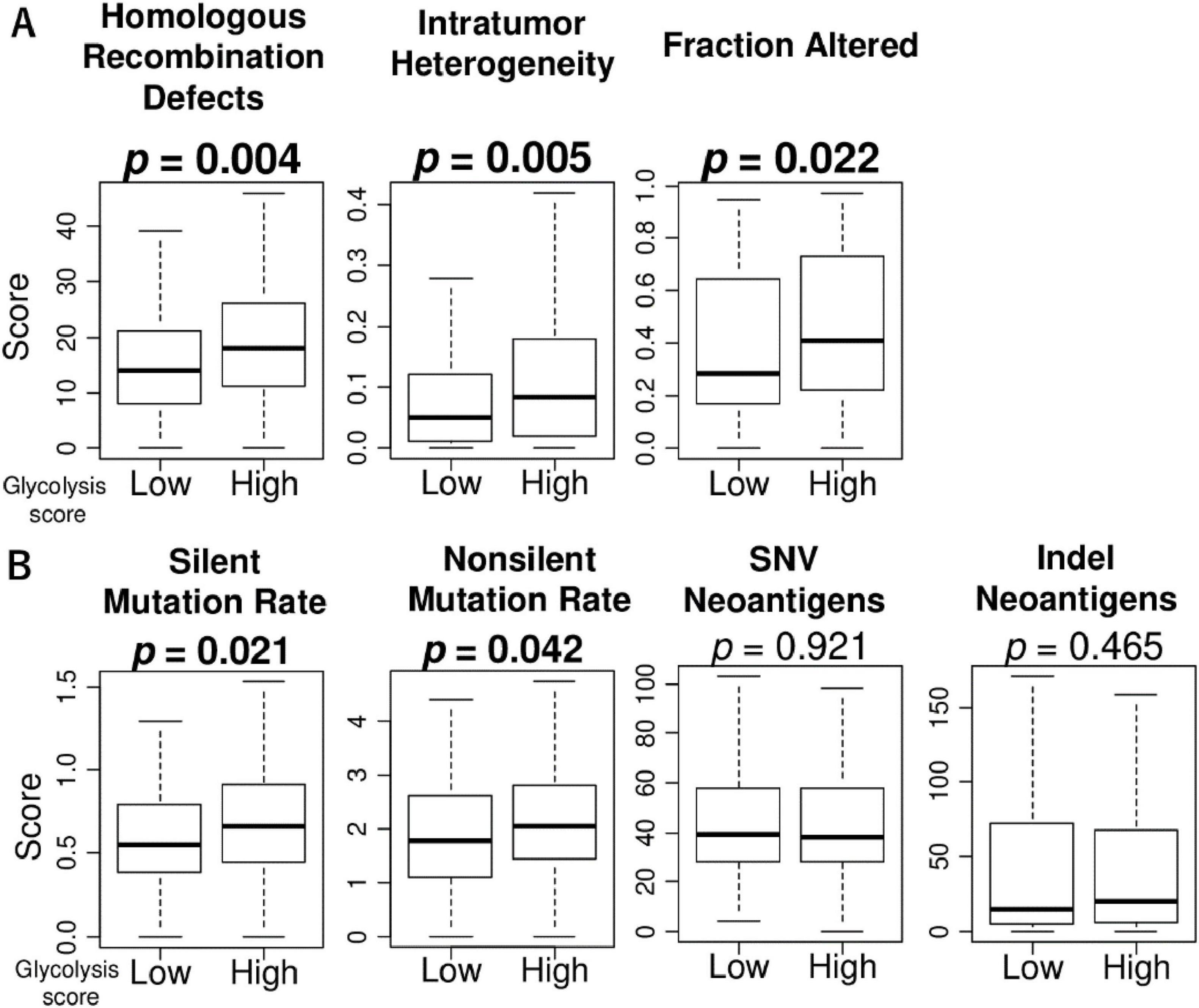
Figure 3. The association of glycolysis signaling with homologous recombination defects, intratumor heterogeneity, fraction altered, as well as mutation-related score in HCC. Box plots of (A) homologous recombination defects, intratumor heterogeneity, and fraction altered score level, and (B) mutation-related scores; silent mutation rate, non-silent mutation rate, single nucleotide variation neoantigens, and indel neoantigens, by low and high glycolysis score groups in the TCGA cohort. Mann Whitney U tests were used to investigate for significant differences between groups. SNV, single nucleotide variation.
3.4 High glycolysis signaling HCC was not associated with infiltration fraction rate or function of immune cells in the tumor microenvironment
Since the association between intratumor heterogeneity and tumor immune microenvironment (TIME) of HCC has been reported in recent years (35), we investigated the relationship between glycolysis signaling score levels and the infiltration rate of several types of immune cells in the tumor microenvironment (TIME) of HCC. The high glycolysis score group demonstrated statistically significantly lower fractures of CD8 + T cells, CD4 + memory T cells, and regulatory T cells, and higher fractions of helper type1 and type2 T cells and M1 macrophages in the TCGA cohort (Figure 4). However, these results were not validated by GSE76427 cohort except for the result of Th1 cells (p = 0.046). Furthermore, there was no association of the score with cytolytic activity score in either cohort. These results suggest that glycolysis signaling level was not associated with immunity in the TIME of HCC.
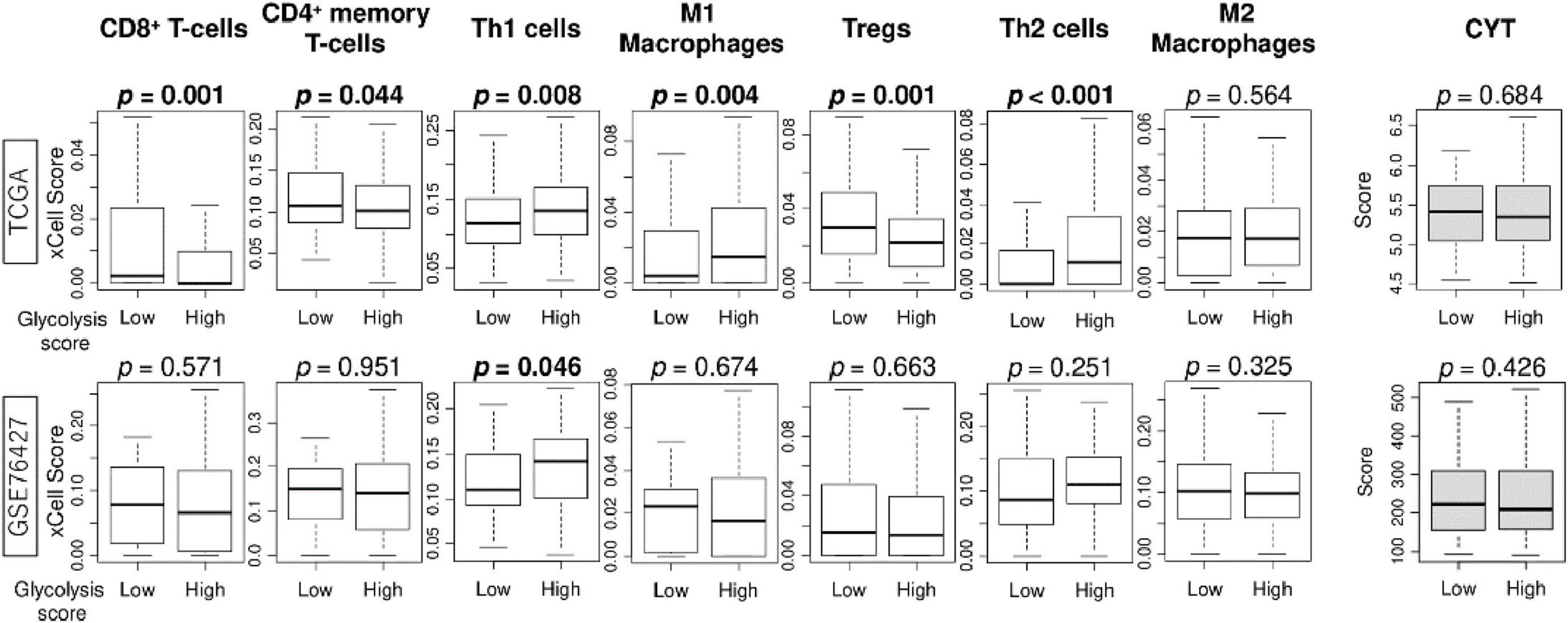
Figure 4. The association of enhanced glycolysis signaling with infiltration rates of immune cells in the tumor microenvironment of HCC in TCGA and GSE76427 cohorts. Boxplots of infiltration rate of CD8 + and CD4 + memory T cells, Th1 cells, M1 macrophages, Tregs, Th2 cells, and M2 macrophages, as well as cytolytic activity score, by low and high glycolysis signaling groups, in both cohorts. Mann Whitney U tests were used to investigate for significant differences between groups. Th, Th1, helper T type 1; Th2, helper T type2; CYT, cytolytic activity.
3.5 High glycolysis signaling HCC was associated with worse patient outcomes
We next investigated the association of glycolysis signaling score levels with clinicopathological features using the TCGA cohort. We found that the score increased with T stage and pathological stage (Figure 5A; both p < 0.001). There was no association between the score and tumor grade (p = 0.240). We next determined whether HCC with enhanced glycolysis signaling was associated with poorer patient prognosis, and glycolysis signaling score did in fact predict worse outcomes in HCC patients. We found that glycolysis signaling score was associated with survival probability (Figure 5B). Kaplan-Meier survival analysis showed that the high glycolysis score group experienced significantly shorter disease-free survival (DFS), disease-specific survival (DSS), overall survival (OS), and progression-free survival (PFS) compared to the low score group in the TCGA cohort (p = 0.001, 0.002, <0.001, and 0.011, respectively). The result for PFS was validated in the GSE76427 cohort (p = 0.022). The above suggests enhanced glycolysis signaling in HCC was significantly associated with poor patient survival, and that the glycolysis signaling score could be used for risk stratification of HCC patients.
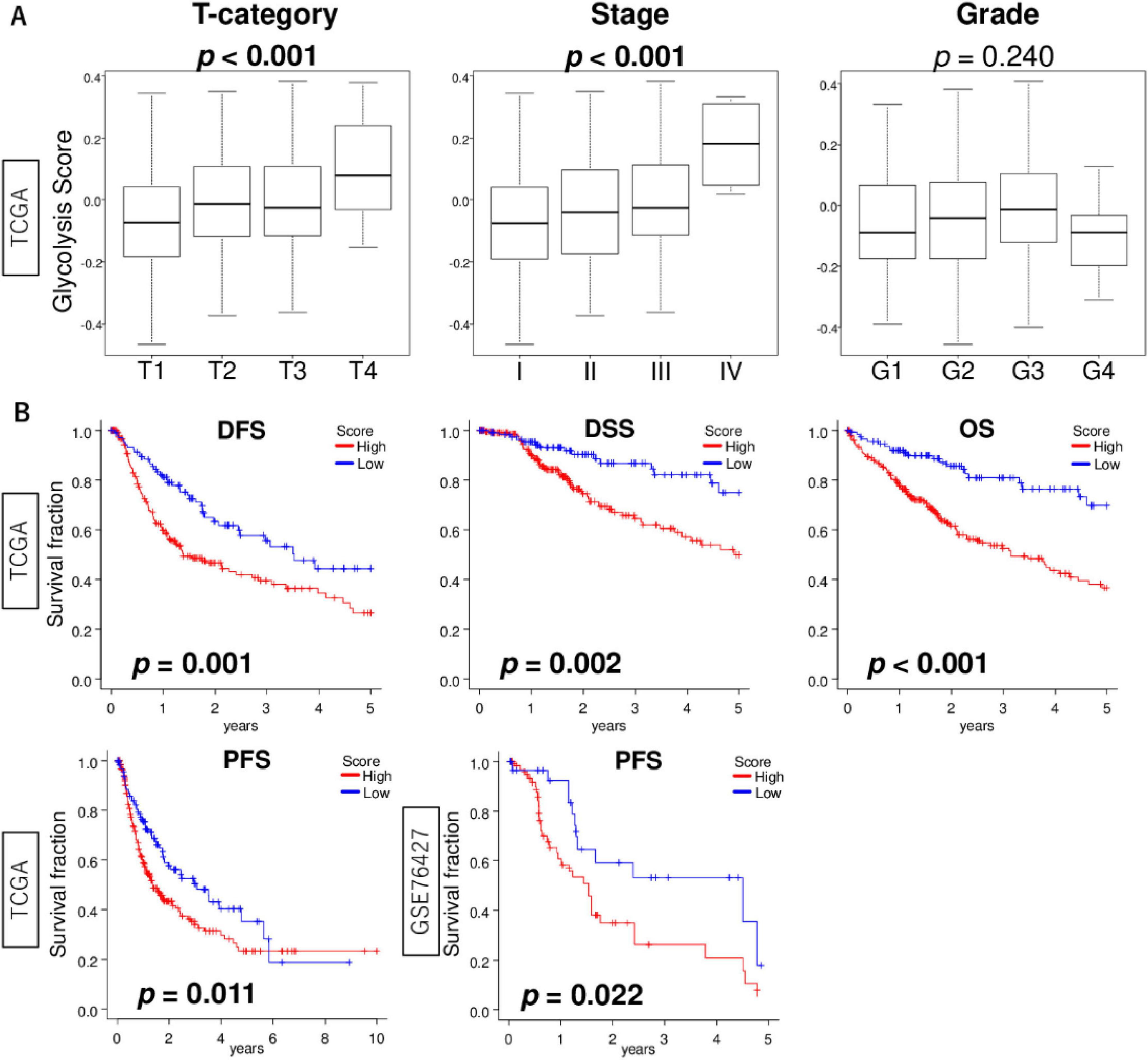
Figure 5. The association of glycolysis signaling score with clinical features of HCC. (A) Box plots of glycolysis signaling score level by T stage (T1–T4), AJCC stage (I–IV), and histological grade (G1–G4) in the TCGA cohort. Krustal-Wallis tests were used to investigate for significant differences between groups. (B) Kaplan-Meier curves with log-rank p-values of DFS, DSS, and OS in the TCGA cohort and PFS in the TCGA and GSE76427 cohorts between HCC with low and high glycolysis signaling scores. AJCC, American joint committee; DFS, disease-free survival; DSS, disease-specific survival; OS, overall survival.
3.6 Glycolysis signaling score was an independent prognostic factor for HCC patients
For the evaluation of possible independent prognostic factors, the following variables were subjected to univariate Cox analysis for OS: age, race, T stage, N stage, M stage, histological grade, and the glycolysis score. In the univariate analysis, T stage, M stage, and the glycolysis score remained as prognostic factors for HCC patients (Table 1). When these results were subsequently subjected to a multivariate Cox analysis, we found that T stage and the glycolysis signaling score were independent, poor prognostic factors of patients with HCC. These results of multivariate analysis indicated that the glycolysis signaling score was an independent predictor of OS as well as DSS for patients with HCC.
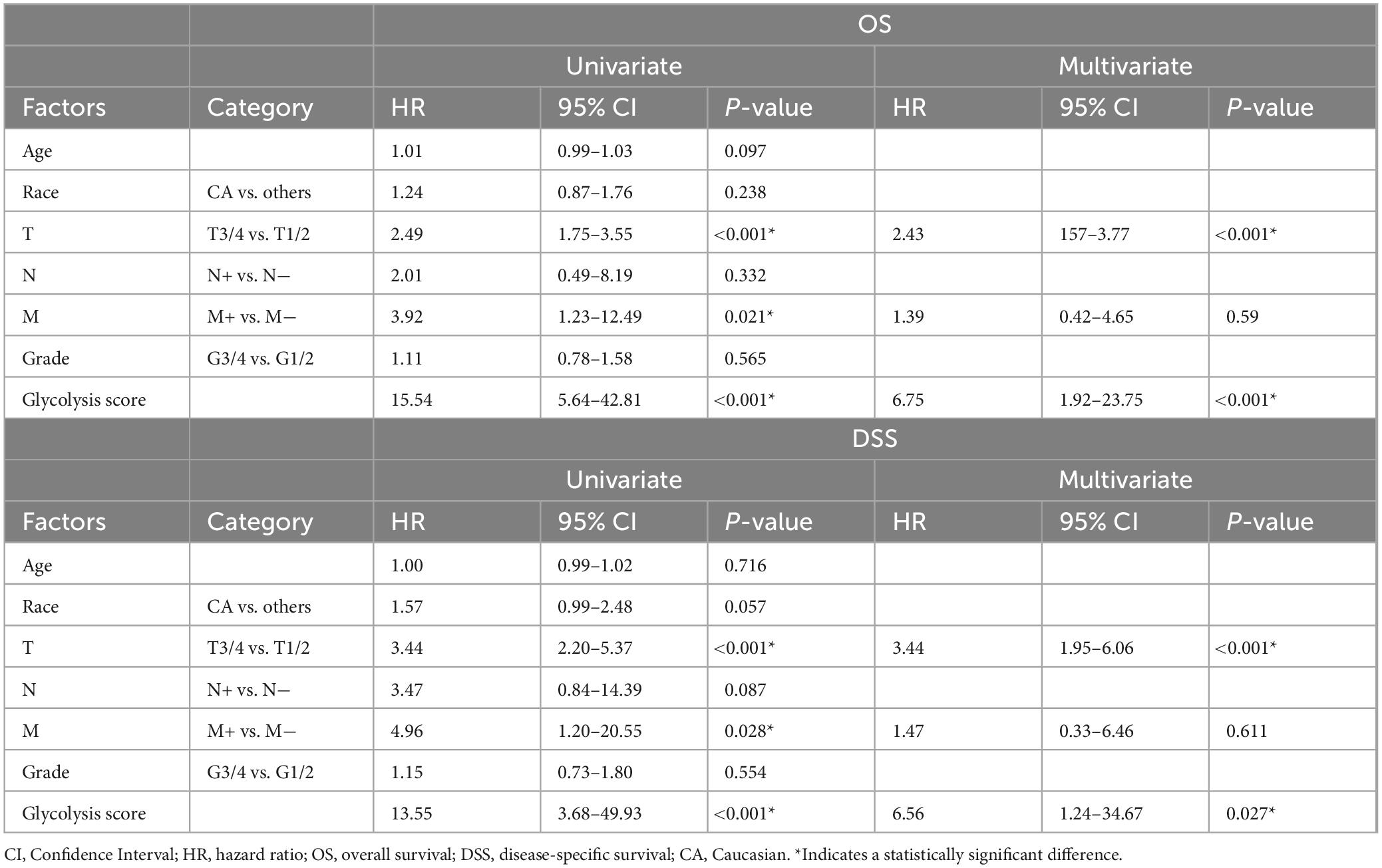
Table 1. Uni- and multivariate analysis in HCC with overall and disease-specific survival in the TCGA cohort.
4 Discussion
This study investigated enhanced glycolysis signaling in liver tissue samples across various liver diseases, particularly HCC. While the glycolysis signaling scores did not differ between HCC and other liver diseases, high glycolysis signaling was consistently linked to cell proliferation-related and other pro-cancerous gene sets. This is supported by recent findings that glycolytic enzymes, such as enolase-1 (ENO1) exhibit moonlighting functions that actively contribute to tumor progression. Specifically, ENO1 promotes choline phospholipid metabolism by stabilizing choline kinase-α, thereby supporting cancer cell proliferation (36). HCC with high glycolysis signaling had more homologous recombination defects, intratumor heterogeneity, and mutation rates. No significant associations with immune cell infiltration were found, except for Th1 cells, consistently in both cohorts. Higher glycolysis signaling scores correlated with advanced disease stage and poorer survival outcomes, making the score as an independent prognostic biomarker for HCC.
High glycolysis signaling was also associated with increased homologous recombination deficiency, intratumoral heterogeneity, and elevated mutation burden. These findings suggest that tumors with heightened glycolytic activity may experience greater genomic instability, potentially driven by increased oxidative stress and disruptions in redox homeostasis. Consistent with this notion, pathway analysis demonstrated that high-glycolysis tumors were enriched for gene sets related to the unfolded protein response (UPR), reactive oxygen species (ROS), and DNA repair. These enriched pathways reflect compensatory mechanisms activated in response to metabolic stress and accumulated DNA damage. In particular, upregulation of ROS- and UPR-associated signaling may exacerbate genomic instability and contribute to impaired DNA repair capacity, further promoting mutagenesis. Collectively, these results support a model in which metabolic reprogramming facilitates a cellular environment permissive to genetic alterations and therapy resistance (37, 38).
Due to the heterogeneity of tumor cells, not all of them rely on glycolysis as their main energy source. Glycolysis contributes 2%–64% of total ATP production in tumor cells. Suganuma et al studied the metabolism of four leukemia cell types using the glycolysis inhibitor 2-deoxy-D-glucose (2-DG) and the OXPHOS inhibitor oligomycin (39). They found that NB4 cells were more sensitive to 2-DG, indicating they depend on glycolysis, while THP-1 cells were resistant to 2-DG but sensitive to oligomycin, indicating a reliance on OXPHOS. These findings suggest that the primary energy metabolism pathway varies among tumors. Therefore, to maximize the effectiveness of antimetabolite treatments, it is crucial to understand the metabolic characteristics of each patient’s tumor cells. However, it is difficult to estimate the enhanced level of glycolysis signaling in cancer cells because of their inherent, high heterogeneity (40, 41). Yu Pan et al. developed an aerobic glycolysis index (AGI) to quantify glycolysis activity in HCC, demonstrating that high AGI correlated with poor tumor differentiation, advanced disease stage, and resistance to sorafenib treatment (42).
Understanding the activation level of glycolysis signaling in HCC is crucial for diagnosis, prognostication, and development of treatment strategies. Therapies targeting glycolytic enzymes and metabolites offer promising new treatments, potentially overcoming treatment resistance and enhancing treatment efficacy. Further elucidation of glycolysis mechanisms and advancements in clinical research hold promise for novel approaches to HCC treatment. In the future, investigating the correlation between the therapeutic response of glycolytic drugs on HCC and this scoring system will be necessary. Our study revealed not only the relationship between glycolysis signaling activity and patient prognosis but also the relationship with various underlying factors, such as mutations and the tumor microenvironment (42). We found that there was no significant correlation between the level of glycolysis signaling and the infiltration fraction of immune cells in the TIME, except for Th1 cells. Th1 cells secrete IFN-γ, which activates macrophages and elicits a robust antitumor immune response (43). In HCC, infiltration of Th1 cells is generally associated with a favorable prognosis, as they help suppress tumor growth (44). On the other hand, there are also reports that the ratio of Th2 cells and Treg cells affects prognosis (45). Thus, various factors in the TIME interact in complex ways and affect patient outcomes, so it is important to understand the whole picture rather than focusing on a single factor. Our study method is useful for understanding the overall picture of cancer, and glycolysis signaling activity has been shown to correlate with patient prognosis as a counterbalance to other factors.
Given its association with poor prognosis, genomic instability, and tumor aggressiveness, glycolysis signaling activity may serve as a robust prognostic indicator in HCC. Therapeutic strategies targeting glycolytic enzymes may be particularly effective in patients with high glycolysis scores. Future studies should explore the predictive value of glycolysis scoring in guiding treatment decisions and developing combination therapies to overcome metabolic resistance. However, this study is subject to several limitations. Firstly, its retrospective nature and reliance on public databases introduce the potential for selection bias attributed to the absence of comprehensive clinical data and treatment specifics. This was countered as much as possible through validation of results in completely independent cohorts. Secondly, this study’s observational nature restricts the depth of mechanistic insights, offering merely a static snapshot at a singular time point. We underscore the necessity for additional investigations utilizing preclinical models to elucidate this intricate underlying mechanism comprehensively in future studies. Further research into the detailed mechanisms of glycolysis and their clinical application will open up new perspectives in the treatment of HCC.
5 Conclusion
High glycolysis signaling was associated with enhanced level of pro-cancerous and cell proliferation-related gene sets, high levels of homologous recombination defects, intratumor heterogeneity, and mutation rates, and advanced disease stage and poorer survival, making it an independent prognostic factor for HCC.
Data availability statement
The datasets presented in this study can be found in online repositories. The names of the repository/repositories and accession number(s) can be found below: All of these datasets are publicly available without restriction through the Gene Expression Omnibus (https://www.ncbi.nlm.nih.gov/geo/) or cBioPortal (https://www.cbioportal.org/). Accession numbers: GSE6764 (Gene Expression Omnibus), GSE76427 (Gene Expression Omnibus), GSE89377 (Gene Expression Omnibus) and TCGA (via cBioPortal).
Ethics statement
Ethical approval was not required for the studies involving humans because all the cohorts/datasets used in this study; the TCGA and GSE cohorts are all publicly available without any restrictions via cBioportal or Gene Expression Omnibus (GEO). The studies were conducted in accordance with the local legislation and institutional requirements. The human samples used in this study were acquired from all the cohorts/datasets used in this study; the TCGA and GSE cohorts are all publicly available without any restrictions via cBioportal or Gene Expression Omnibus (GEO). Written informed consent to participate in this study was not required from the participants or the participants’ legal guardians/next of kin in accordance with the national legislation and the institutional requirements.
Author contributions
MO: Conceptualization, Formal analysis, Investigation, Methodology, Project administration, Visualization, Writing – original draft. CR: Conceptualization, Writing – review & editing. LY: Conceptualization, Formal analysis, Writing – review & editing. IE: Conceptualization, Writing – review & editing. KT: Conceptualization, Funding acquisition, Methodology, Project administration, Writing – review & editing.
Funding
The author(s) declare that financial support was received for the research and/or publication of this article. This work was supported by National Institutes of Health, USA grant R01CA160688, R01CA250412, and R37CA248018, as well as US Department of Defense BCRP grant W81XWH-19-1-0674 to KT, Grants-in-Aid for Scientific Research from the Japan Society for the Promotion of Science, JSPS grant number 23K14600 to MO, and National Cancer Institute, USA Cancer Center Support grant P30-CA016056 to Roswell Park Comprehensive Cancer Center (RPCCC).
Conflict of interest
The authors declare that the research was conducted in the absence of any commercial or financial relationships that could be construed as a potential conflict of interest.
Generative AI statement
The author(s) declare that no Generative AI was used in the creation of this manuscript.
Any alternative text (alt text) provided alongside figures in this article has been generated by Frontiers with the support of artificial intelligence and reasonable efforts have been made to ensure accuracy, including review by the authors wherever possible. If you identify any issues, please contact us.
Publisher’s note
All claims expressed in this article are solely those of the authors and do not necessarily represent those of their affiliated organizations, or those of the publisher, the editors and the reviewers. Any product that may be evaluated in this article, or claim that may be made by its manufacturer, is not guaranteed or endorsed by the publisher.
References
1. Singleterry J, Sreedhar A, Zhao Y. Components of cancer metabolism and therapeutic interventions. Mitochondrion. (2014) 17:50–5. doi: 10.1016/j.mito.2014.05.010
2. Zhao Y, Liu H, Riker A, Fodstad O, Ledoux S, Wilson G, et al. Emerging metabolic targets in cancer therapy. Front Biosci. (2011) 16:1844–60. doi: 10.2741/3826
3. Vander Heiden M, Cantley L, Thompson C. Understanding the Warburg effect: the metabolic requirements of cell proliferation. Science. (2009) 324:1029–33. doi: 10.1126/science.1160809
4. Zheng J. Energy metabolism of cancer: glycolysis versus oxidative phosphorylation (Review). Oncol Lett. (2012) 4:1151–7. doi: 10.3892/ol.2012.928
5. Feng J, Li J, Wu L, Yu Q, Ji J, Wu J, et al. Emerging roles and the regulation of aerobic glycolysis in hepatocellular carcinoma. J Exp Clin Cancer Res. (2020) 39:126. doi: 10.1186/s13046-020-01629-4
6. Yang Y, Ren P, Liu X, Sun X, Zhang C, Du X, et al. PPP1R26 drives hepatocellular carcinoma progression by controlling glycolysis and epithelial-mesenchymal transition. J Exp Clin Cancer Res. (2022) 41:101. doi: 10.1186/s13046-022-02302-8
7. Ramos-Santillan V, Oshi M, Nelson E, Endo I, Takabe K. High Ki67 gene expression is associated with aggressive phenotype in hepatocellular carcinoma. World J Oncol. (2024) 15:257–67. doi: 10.14740/wjon1751
8. Sarkar J, Oshi M, Satyananda V, Chida K, Yan L, Maiti A, et al. Spinster homologue 2 expression correlates with improved patient survival in hepatocellular carcinoma despite association with lymph-angiogenesis. World J Oncol. (2024) 15:181–91. doi: 10.14740/wjon1732
9. Oshi M, Gandhi S, Yan L, Tokumaru Y, Wu R, Yamada A, et al. Abundance of reactive oxygen species (ROS) is associated with tumor aggressiveness, immune response, and worse survival in breast cancer. Breast Cancer Res Treat. (2022) 194:231–41. doi: 10.1007/s10549-022-06633-0
10. Takahashi H, Oshi M, Yan L, Endo I, Takabe K. Gastric cancer with enhanced apical junction pathway has increased metastatic potential and worse clinical outcomes. Am J Cancer Res. (2022) 12:2146–59.
11. Wu R, Yu I, Tokumaru Y, Asaoka M, Oshi M, Yan L, et al. Elevated bile acid metabolism and microbiome are associated with suppressed cell proliferation and better survival in breast cancer. Am J Cancer Res. (2022) 12:5271–85.
12. Chida K, Oshi M, Roy A, Yachi T, Nara M, Yamada K, et al. E2F target score is associated with cell proliferation and survival of patients with hepatocellular carcinoma. Surgery. (2023) 174:307–14. doi: 10.1016/j.surg.2023.04.030
13. Oshi M, Gandhi S, Wu R, Asaoka M, Yan L, Yamada A, et al. Development of a novel BRCAness score that predicts response to PARP inhibitors. Biomark Res. (2022) 10:80. doi: 10.1186/s40364-022-00427-8
14. Mounir M, Lucchetta M, Silva T, Olsen C, Bontempi G, Chen X, et al. New functionalities in the TCGAbiolinks package for the study and integration of cancer data from GDC and GTEx. PLoS Comput Biol. (2019) 15:e1006701. doi: 10.1371/journal.pcbi.1006701
15. Wurmbach E, Chen Y, Khitrov G, Zhang W, Roayaie S, Schwartz M, et al. Genome-wide molecular profiles of HCV-induced dysplasia and hepatocellular carcinoma. Hepatology. (2007) 45:938–47. doi: 10.1002/hep.21622
16. Grinchuk O, Yenamandra S, Iyer R, Singh M, Lee H, Lim K, et al. Tumor-adjacent tissue co-expression profile analysis reveals pro-oncogenic ribosomal gene signature for prognosis of resectable hepatocellular carcinoma. Mol Oncol. (2018) 12:89–113. doi: 10.1002/1878-0261.12153
17. Shen Q, Eun J, Lee K, Kim H, Yang H, Kim S, et al. Barrier to autointegration factor 1, procollagen-lysine, 2-oxoglutarate 5-dioxygenase 3, and splicing factor 3b subunit 4 as early-stage cancer decision markers and drivers of hepatocellular carcinoma. Hepatology. (2018) 67:1360–77. doi: 10.1002/hep.29606
18. Oshi M, Chida K, Roy A, Mann G, An N, Yan L, et al. Higher inflammatory response in hepatocellular carcinoma is associated with immune cell infiltration and a better outcome. Hepatol Int. (2024) 18:1299–309. doi: 10.1007/s12072-024-10678-2
19. Chida K, Oshi M, An N, Kanazawa H, Roy A, Mann G, et al. Gastric cancer with enhanced myogenesis is associated with less cell proliferation, enriched epithelial-to-mesenchymal transition and angiogenesis, and poor clinical outcomes. Am J Cancer Res. (2024) 14:355–67. doi: 10.62347/NCIM3072
20. Subramanian A, Tamayo P, Mootha V, Mukherjee S, Ebert B, Gillette M, et al. Gene set enrichment analysis: a knowledge-based approach for interpreting genome-wide expression profiles. Proc Natl Acad Sci USA. (2005) 102:15545–50. doi: 10.1073/pnas.0506580102
21. Oshi M, Patel A, Le L, Tokumaru Y, Yan L, Matsuyama R, et al. G2M checkpoint pathway alone is associated with drug response and survival among cell proliferation-related pathways in pancreatic cancer. Am J Cancer Res. (2021) 11:3070–84.
22. Oshi M, Satyananda V, Angarita F, Kim T, Tokumaru Y, Yan L, et al. Angiogenesis is associated with an attenuated tumor microenvironment, aggressive biology, and worse survival in gastric cancer patients. Am J Cancer Res. (2021) 11:1659–71.
23. Oshi M, Tokumaru Y, Angarita F, Lee L, Yan L, Matsuyama R, et al. Adipogenesis in triple-negative breast cancer is associated with unfavorable tumor immune microenvironment and with worse survival. Sci Rep. (2021) 11:12541. doi: 10.1038/s41598-021-91897-7
24. Oshi M, Tokumaru Y, Angarita F, Yan L, Matsuyama R, Endo I, et al. Degree of early estrogen response predict survival after endocrine therapy in primary and metastatic ER-Positive breast cancer. Cancers. (2020) 12:3557. doi: 10.3390/cancers12123557
25. Oshi M, Tokumaru Y, Patel A, Yan L, Matsuyama R, Endo I, et al. A novel four-gene score to predict pathologically complete (R0) resection and survival in pancreatic cancer. Cancers. (2020) 12:3635. doi: 10.3390/cancers12123635
26. Oshi M, Asaoka M, Tokumaru Y, Yan L, Matsuyama R, Ishikawa T, et al. CD8 T cell score as a prognostic biomarker for triple negative breast cancer. Int J Mol Sci. (2020) 21:6968. doi: 10.3390/ijms21186968
27. Oshi M, Kawaguchi T, Yan L, Peng X, Qi Q, Tian W, et al. Immune cytolytic activity is associated with reduced intra-tumoral genetic heterogeneity and with better clinical outcomes in triple negative breast cancer. Am J Cancer Res. (2021) 11:3628–44.
28. Oshi M, Newman S, Tokumaru Y, Yan L, Matsuyama R, Kalinski P, et al. Plasmacytoid dendritic cell (pDC) infiltration correlate with tumor infiltrating lymphocytes, cancer immunity, and better survival in triple negative breast cancer (TNBC) more strongly than conventional dendritic cell (cDC). Cancers. (2020) 12:3342. doi: 10.3390/cancers12113342
29. Oshi M, Gandhi S, Huyser M, Tokumaru Y, Yan L, Yamada A, et al. MELK expression in breast cancer is associated with infiltration of immune cell and pathological compete response (pCR) after neoadjuvant chemotherapy. Am J Cancer Res. (2021) 11:4421–37.
30. Oshi M, Asaoka M, Tokumaru Y, Angarita F, Yan L, Matsuyama R, et al. Abundance of regulatory T Cell (Treg) as a predictive biomarker for neoadjuvant chemotherapy in triple-negative breast cancer. Cancers. (2020) 12:3038. doi: 10.3390/cancers12103038
31. Oshi M, Angarita F, Tokumaru Y, Yan L, Matsuyama R, Endo I, et al. A novel three-gene score as a predictive biomarker for pathologically complete response after neoadjuvant chemotherapy in triple-negative breast cancer. Cancers. (2021) 13:2401. doi: 10.3390/cancers13102401
32. Oshi M, Gandhi S, Tokumaru Y, Yan L, Yamada A, Matsuyama R, et al. Conflicting roles of EGFR expression by subtypes in breast cancer. Am J Cancer Res. (2021) 11:5094–110.
33. Oshi M, Newman S, Tokumaru Y, Yan L, Matsuyama R, Endo I, et al. Inflammation is associated with worse outcome in the whole cohort but with better outcome in triple-negative subtype of breast cancer patients. J Immunol Res. (2020) 2020:5618786. doi: 10.1155/2020/5618786
34. Thorsson V, Gibbs D, Brown S, Wolf D, Bortone D, Ou Yang T, et al. The immune landscape of cancer. Immunity. (2019) 51:411–2. doi: 10.1016/j.immuni.2019.08.004
35. Zhang S, Yuan L, Danilova L, Mo G, Zhu Q, Deshpande A, et al. Spatial transcriptomics analysis of neoadjuvant cabozantinib and nivolumab in advanced hepatocellular carcinoma identifies independent mechanisms of resistance and recurrence. Genome Med. (2023) 15:72. doi: 10.1186/s13073-023-01218-y
36. Ma Q, Jiang H, Ma L, Zhao G, Xu Q, Guo D, et al. The moonlighting function of glycolytic enzyme enolase-1 promotes choline phospholipid metabolism and tumor cell proliferation. Proc Natl Acad Sci USA. (2023) 120:e2209435120. doi: 10.1073/pnas.2209435120
37. Morandi A, Indraccolo S. Linking metabolic reprogramming to therapy resistance in cancer. Biochim Biophys Acta Rev Cancer. (2017) 1868:1–6. doi: 10.1016/j.bbcan.2016.12.004
38. Liu S, Zhang X, Wang W, Li X, Sun X, Zhao Y, et al. Metabolic reprogramming and therapeutic resistance in primary and metastatic breast cancer. Mol Cancer. (2024) 23:261. doi: 10.1186/s12943-024-02165-x
39. Goto M, Miwa H, Suganuma K, Tsunekawa-Imai N, Shikami M, Mizutani M, et al. Adaptation of leukemia cells to hypoxic condition through switching the energy metabolism or avoiding the oxidative stress. BMC Cancer. (2014) 14:76. doi: 10.1186/1471-2407-14-76
40. Park J, Pyun W, Park H. Cancer metabolism: Phenotype, signaling and therapeutic targets. Cells. (2020) 9:2308. doi: 10.3390/cells9102308
41. Neugent M, Goodwin J, Sankaranarayanan I, Yetkin C, Hsieh M, Kim JWA. New perspective on the heterogeneity of cancer glycolysis. Biomol Ther. (2018) 26:10–8. doi: 10.4062/biomolther.2017.210
42. Pan Y, Hu G, Jiang S, Xia S, Maher H, Lin Z, et al. Development of an aerobic glycolysis index for predicting the sorafenib sensitivity and prognosis of hepatocellular carcinoma. Front Oncol. (2021) 11:637971. doi: 10.3389/fonc.2021.637971
43. Sadanaga N, Nagoshi M, Lederer J, Joo H, Eberlein T, Goedegebuure P. Local secretion of IFN-gamma induces an antitumor response: comparison between T cells plus IL-2 and IFN-gamma transfected tumor cells. J Immunother. (1999) 22:315–23. doi: 10.1097/00002371-199907000-00005
44. Budhu A, Forgues M, Ye Q, Jia H, He P, Zanetti K, et al. Prediction of venous metastases, recurrence, and prognosis in hepatocellular carcinoma based on a unique immune response signature of the liver microenvironment. Cancer Cell. (2006) 10:99–111. doi: 10.1016/j.ccr.2006.06.016
Keywords: biomarker, carcinogenesis, hepatocellular carcinoma, glycolysis, survival
Citation: Oshi M, Rog C, Yan L, Endo I and Takabe K (2025) Enhanced glycolysis is associated with aggressive tumor phenotype and worse outcomes in hepatocellular carcinoma patients. Front. Med. 12:1588604. doi: 10.3389/fmed.2025.1588604
Received: 09 March 2025; Accepted: 04 August 2025;
Published: 26 August 2025.
Edited by:
Sandra Milić, University of Rijeka, CroatiaReviewed by:
Wenjing Zhu, University of Health and Rehabilitation Sciences (Qingdao Municipal Hospital), ChinaGuijun Zhao, Endoscopy Center, China
Copyright © 2025 Oshi, Rog, Yan, Endo and Takabe. This is an open-access article distributed under the terms of the Creative Commons Attribution License (CC BY). The use, distribution or reproduction in other forums is permitted, provided the original author(s) and the copyright owner(s) are credited and that the original publication in this journal is cited, in accordance with accepted academic practice. No use, distribution or reproduction is permitted which does not comply with these terms.
*Correspondence: Masanori Oshi, b3NoaS5tYXMud2NAeW9rb2hhbWEtY3UuYWMuanA=
 Masanori Oshi
Masanori Oshi Colin Rog1
Colin Rog1 Li Yan
Li Yan Kazuaki Takabe
Kazuaki Takabe